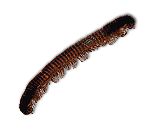General Characteristics:
- Millipedes are very common found throughout Canada
- They are similar to centipedes but differ because they have round oval bodies and two pairs of legs for almost each body segment
- Millipedes measure from ½-1 ½ inches in length
- Brownish in colour
- Feeds on damp and decaying vegetable matter
- No dangerous species in Canada
- Do not bite or have poisonous fangs
- 10 000 species worldwide / More than 60 species in Canada
Reproduction:
- Reproduction is similar to centipedes
- Lays eggs in nest and guards them
- Young are only born with 3 pairs of legs and grow more as the molt (grow and shed skin)
Signs of Infestation:
- Occasionally find their way into structures, but prefer to live outdoors in leaves, garden mulch, roots, compost areas, etc…
- In defence, they roll into a ball and some may emit and odour to deter predators
- If insect is present in large numbers a moisture problem may be present in the structure and should repaired before treatment
Control Techniques:
- Sealing or repairing structure and keeping areas dry will limit access and aid in control of this insect
- Professional inspection evaluations should be conducted to determine structural condition and most appropriate control measures
Please click here to contact a Focus Pest Control professional to inquire about further treatments for this pest species.
References:
Benett, Gary W., et.al.. Truman’s Scientific Guide to Pest Control Operations. Duluth: Advanstar Communications, 1988. Pp. 36, 251.
“Millipede” (On-line). The Canadian Encyclopaedia Historica. Accessed May 15, 2009 at http://www.thecanadianencyclopedia.com/index.cfm?PgNm=TCE&Params=A1ARTA0005305.
Myers, P. 2001. "Diplopoda" (On-line), Animal Diversity Web. Accessed May 15, 2009 at
http://animaldiversity.ummz.umich.edu/site/accounts/information/Diplopoda.html.
Olkowski, William, et.al.. Common-Sense Pest Control. Newton,CT. The Taunton Press Inc., 1991. Pp. 61-62.
Disclaimer:
The Focus Pest Control ‘Pest Library’ is an educational resource written largely to educate the general public about common pests in Ontario. The Focus ‘Pest Library’ does not include all species in Ontario, nor does it include the most recent scientific data about species we describe. Though we edit our accounts for accuracy, we cannot guarantee all information in those accounts. While Focus Pest Control staff and contributors provide references to books and websites that we believe are reputable, we cannot necessarily endorse the contents of references beyond our control.
(Back to top)
|


